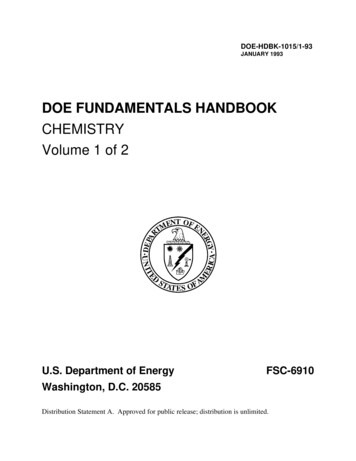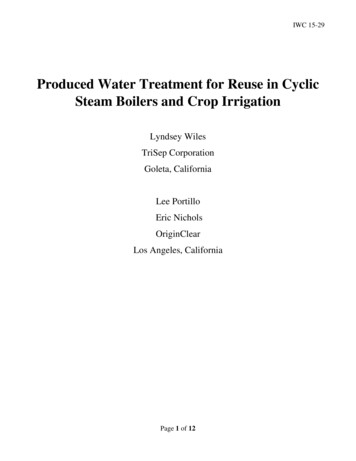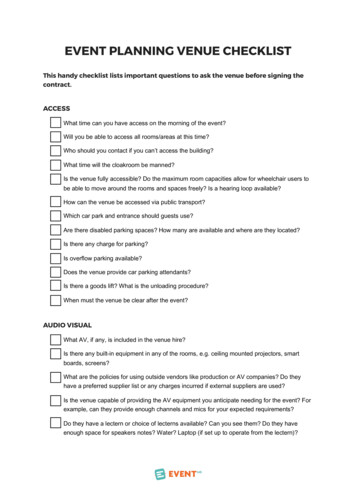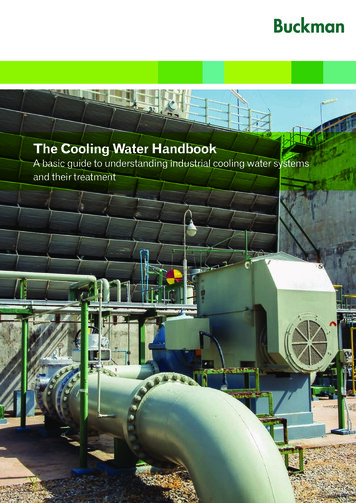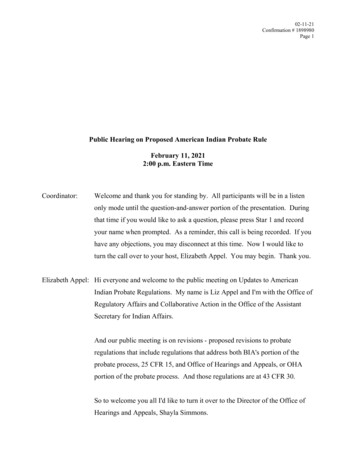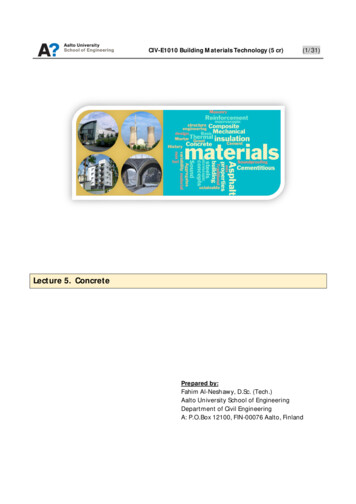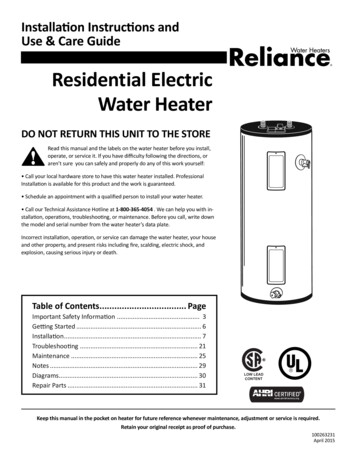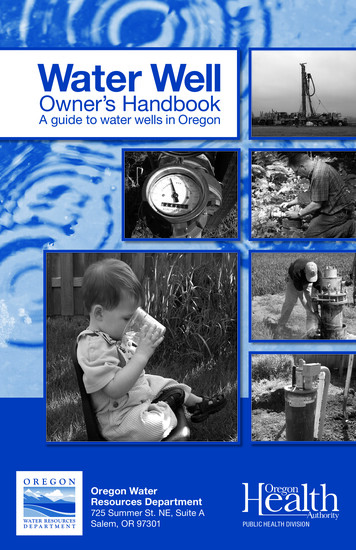
Transcription
Water WellOwner’s HandbookA guide to water wells in OregonOregon WaterResources Department725 Summer St. NE, Suite ASalem, OR 97301PUBLIC HEALTH DIVISION
Why you should read this bookletGroundwater is an important water source for homes, farms,industries and businesses in Oregon. This booklet providesgeneral information about: GroundwaterWater wellsWell constructionProtection of groundwaterWell operation and maintenanceSafe drinking water supplyWater well abandonmentOregon rules and statutes on water wellsThis information is valuable if you own, wish to construct or planto abandon a water well in Oregon. It may also be helpful to peoplerenting, selling or buying property where wells are or will be locatedto meet water supply needs. This information may not apply to allsituations and may change. Wells used for a public water system havedifferent standards. Contact Oregon Drinking Water Services forinformation: 971-673-0405.PUBLIC HEALTH DIVISIONThe Water ResourcesDepartment recognizes theOregon Health Authority’sDomestic Well SafetyProgram and DrinkingWater Services, and theGroundwater AdvisoryCommittee (GWAC)who contributed to andreviewed this publication.For questions on well water quantity or wellconstruction requirements, please contact:Oregon Water Resources Department725 Summer Street NE, Suite ASalem, OR 97301-1266503-986-0900www.oregon.gov/OWRDFor questions on water quality for domesticwells, please contact:Oregon Domestic Well Safety Program800 NE Oregon St, Suite 640Portland, OR 97232-2162971-673-0440www.healthoregon.org/wells
Table of contentsBasic groundwater and water well information. 1What is groundwater?.1What is a water well?.2How does a well work?.4Groundwater rights and exempt uses. 5Groundwater use registration.6Obtaining groundwater rights.7Estimating your groundwater needs. 8Managing water use.9Installing a measuring tube. 11Well efficiency. 13Sharing a water well.14Water well construction. 15Planning your well.15Drilling a well.15Oregon well construction standards.16Selecting a well constructor. 17Selecting a site for your well.19Purchasing and installing a pump.21Water well documentation. 22Well identification number.22Water supply well report.23How to read a well report.23Water well maintenance. 28Well performance and rehabilitation.29Water quality testing.29Water contamination and health effects.31Treatment options.33Well abandonment.36Water well in an emergency. 37Buying or selling a property with a well. 39Oregon Water Resources Department contact information. 41Region offices/well inspectors. 41District watermasters. 42Useful terms, abbreviations and web links. 43Terms.43Units of measurement.46Abbreviations.46Web links.46Water well maintenance log. 48
Basic groundwater and water well informationWhat is groundwater?Groundwater is water that fills the pore spaces between sands, gravelor fractures in rock formations in the ground. It is a source of watersupply for public, agriculture, commercial, industrial and domesticuses. Groundwater quality can vary based on geology, climate andland use.UnsaturatedzoneAquifer diagramNon-flowing Artesian wellWater table wellWatertableSaturatedzoneStreamDirection of groundwater flowUnconfined aquiferConfining layerConfined aquiferThis diagram shows a typical aquifer system. Common definitions of groundwater and wellterms are included in the back of this booklet.The diagram above shows how rainfall gets through unsaturated soilsto recharge the upper aquifer (the geologic materials that store andrelease groundwater). In this example, the upper aquifer is consideredunconfined because there is no layer above that restricts the riseand fall of the water table (the upper surface of the saturated zone).The water table will rise and fall in response to many influences, butcommonly to the addition of water (recharge) and the removal ofwater (discharge) from the aquifer. The lower aquifer in the diagramis considered confined because it is bounded by geologic materialsthat restrict groundwater movement, identified in the diagram as the1
confining layer. This aquifer is under pressure, known as artesianpressure, as indicated by the rise in water level above the confininglayer in a well that gets water from the confined aquifer.Groundwater flows from recharge areas (generally around uplands)to discharge areas (from lowlands to streams, lakes and springs).The flow path that groundwater takes may be very localized or canextend for many miles. Most groundwater is brought to the surfaceby water wells or discharges naturally into streams, lakes or springs.What is a water well?A water well is an artificial opening or artificially altered naturalopening, however made, by which groundwater is sought, or flowsunder natural pressure, or is artificially withdrawn or injected.Examples would include holes drilled, bored, dug or jetted into theground to reach water. Wells are usually held open by a pipe, wellcasing or a liner and can provide drinking water or can be used fornon-potable uses such as irrigating and washing. A well is privateor domestic if it serves water for no more than three householdsfor drinking, culinary or household uses and is not used as a publicwater supply.Water wells in unconfined aquifers are known as water-table wells.The water level in these wells is the same as the surrounding aquifer.A pump is used to bring water to the surface for use. Water wells inconfined aquifers are known as artesian wells. Pressure causes thewater level to rise in the well to an elevation higher than the waterlevel in the surrounding aquifer. Sometimes this water may be underenough pressure to flow out of the top of the well casing. This typeof well is called a flowing artesian well.2
Water well diagramAccess portWells must have a port to allow access for measuringwater level.To water delivery systemWell identification numberTop terminal heightThe top of the well must be capped and extend atleast one foot above finished ground surface orpump-house floor.Sands and gravelWell sealThe seal prevents surface water from entering the well.The well must be sealed to at least 18 feet or 5 feet intoa consolidated layer, whichever is greater.Water bearing sands and gravelsImpermeable layerWater cannot penetrate this layer which prevents theupper aquifer from commingling with or contaminatingthe lower aquifer. Sealing the well below this point isrequired to prevent commingling.CasingThe casing supports the sides of the well andprevents the well hole from caving.Non water-bearing conglomeratesStatic water levelThe stabilization level or elevation of water surfacein a well not being pumped.PerforationsHoles in the casing allow water to enter the well.Riser pipe and pump wiringWater-bearing zonePumpSometimes the pump is mounted on the top of the well.Generally, domestic wells use submersible pumps.This diagram shows the different components that make up a well.3
How does a well work?Wells are designed to be open to the aquifer; water is free to moveinto the well from the aquifer. When completely at rest, the water levelin a well and the groundwater level in the aquifer outside the wellare the same. When a pump in a well is turned on, the water levelin the borehole drops in response to the extraction of water from thewell, setting up a pressure gradient between the well (low pressure)and aquifer outside the well (higher pressure). This gradient allowsgroundwater to flow from the aquifer into the well from all directionsto replace water that is pumped out. This process creates a circulardepression in the water table, centered at the well, and is referred toas the cone of depression. As water continues to be pumped from thewell (and the aquifer) the cone of depression will expand over time andmay eventually intersect other wells, causing lower water levels in thoseboreholes. This influence of one well upon another is referred to ashydraulic interference, and in severe cases may prevent a well user fromgetting their typical quantity of water. Pumping groundwater from awell may also intercept groundwater flowing towards a stream, lake orspring. In cases where a well is located close to a stream, pumping thewell may cause surface water to flow into the aquifer.Hydraulic interference diagramWater tablebefore pumpingDrawdownPumping waterlevel in wellThis diagram shows the influence of one well on other, also known as hydraulic interference.4
Groundwater rights and exempt usesUnder Oregon law, “all water within the state from all sources ofwater supply belongs to the public.” In general you must obtaina water right permit before using water from any well. However,there are exceptions called “exempt uses” (see ORS 537.545).These uses are excused from applying for a water right permit, butmust be beneficial and without waste.Pumping groundwater under the exemption carries the sameweight as a water right and has a priority date. An exempt useis subject to the same privileges and restrictions as any waterright permit or certificate and is subject to state water law. TheOregon Water Resources Department (OWRD) has the authorityto regulate, reduce or stop groundwater withdrawals when theyinterfere with prior or “senior” water rights.Exempt uses of groundwater include: Single or group domestic uses up to 15,000 gallons per day; Stock watering; Irrigation of any lawn or noncommercial garden of ½-acreor less; Down-hole heat exchangers; Single industrial or commercial purpose up to 5,000 gallonsper day; or Irrigation of school property up to 10 acres in criticalgroundwater areas.Exempted uses are on a per-property or per-development basis.Adding additional wells does not increase an exempt limitation(for example, adding a second well does not increase the irrigationexemption to more than ½-acre).The Oregon Water Resources Commission is responsible formanaging the groundwater resource. In many areas, high demandof groundwater supplies has required that new uses be restrictedor prohibited to protect existing water rights. This includes exempt5
uses in some areas. Before spending money on a planned well,you should consult OWRD to confirm Oregon water lawallows the proposed use of water.Groundwater use registrationNew wells constructed in Oregon that do not require a water rightare subject to a one-time recording fee. This fee is paid by thelicensed water well constructor (driller), or landowner with a permitand bond to construct a well, at the same time the well report issubmitted (within 30 days of completion of the well). Drillers andlandowners who construct their own wells are also required tosubmit a map showing the well location on the tax lot. When themap and fee are received, OWRD will complete the recordingprocess and make the map available for viewing, along with thewell report, on the OWRD website.The purpose of the fee and map is to improve the management ofgroundwater resources throughout the state. This is done in two ways: The map shows the location of the well within a tax lot,which OWRD uses to identify the supply and availability ofgroundwater. The fee is intended to support additional research in additionto evaluation of groundwater supplies, conducting groundwaterstudies, carrying out groundwater monitoring and processinggroundwater data.For more information about the groundwater use registrationprogram please call 971-287-8360 or visit OWRD’s website (seeUseful web links section).6
Obtaining groundwater rightsIf you plan to use more groundwater than the exempt limit or fora use that is not exempt, a groundwater right permit is requiredbefore beginning construction of any proposed well. To apply for anew groundwater right permit, file an application with OWRD thatincludes a map of the proposed well location and place of proposedwater use. The application is reviewed to ensure the use doesn’tinterfere with existing water rights or stream flow. You may needhelp from a certified water right examiner to collect and reportdata and conduct surveys when applying. The OWRD website listsexaminers in your area. Some Oregon counties require land usepermits for certain developments. Contact your county governmentfor development requirements.7
Estimating your groundwater needsThe U.S. Geological Survey (USGS) estimates that indoor water useaverages 80 to 100 gallons per day for each person:Table 1 Water use estimationsBathA full tub is about 36 gallons.Shower2–2.5 gallons per minute. Old shower heads use asmuch as 4 gallons per minute.Teeth brushing 1 gallon, especially if water is turned off whilebrushing. Newer bath faucets use about 1 gallon perminute, older models use more than 2 gallons.Hands/face washing1 gallonFace/leg shaving1 gallonDishwasher20 gallons/load, depending on efficiency of dishwasherDishwashing by hand4 gallons/minute for old faucets. Newer kitchen faucetsuse about 1–2 gallons per minutes.Clothes washer25 gallons/load for newer washers. Older models useabout 40 gallons per load.Toilet flush3 gallons for older models. Most new toilets use 1.2–1.6gallons per flush.Glasses of water drunk8 oz. per glassOutdoor watering2 gallons per minuteThe largest household use is flushing toilets followed by showersand baths. Daily use per person can drop dramatically by installingwater saving devices.8
A well producing half a gallon per minute will yield 720 gallonsof water per day and supply the inside water needs of mosthouseholds. However, this low yield may not be adequate duringperiods of peak water demand.Managing water useThere are several ways to manage low yield wells to stretch alimited supply: Conservation - Install water savings appliances. Spread use over time - Examples include taking onlyone shower at a time or delaying uses such as laundry ordishwashing to times when demand is low. Storage - Add a storage tank to fill at times of low use.A water meter can also be installed and used to measure how muchwater is being pumped. This information is valuable to understandand manage water use. Domestic well water meters vary in pricefrom 50– 300. For other conservation tips, see page 10.This photo is an example of a water meter device.9
Water conservation saves money by reducing pumping costs and byextending the life of the pump and septic systems.Maintain the water delivery system to prevent leaks. If the pump cycles onand off when water isn’t being used, it is likely there is a leak.Check for and fix leaky faucets inside and outside your home. One drop persecond wastes 2,700 gallons of water per year.Install water-saving devices (front-loading washing machines, low-flowshowerheads, low-flow toilets, water efficient dishwasher).Turn off water while brushing teeth, scrubbing hands or shaving.Run full loads of dishes and laundry.Reduce water use in your lawn or garden during periods of rainfall. Rainsensors on compatible automatic watering systems do this automatically.Use low-flow outdoor irrigation devices such as drip irrigation systems.Landscape with low-water need or native plants.Allow lawns to go dormant during dry periods.Limit car washing and use a shutoff nozzle on the hose when you do. Wash yourcar on the lawn (with biodegradable soap) to allow infiltration into the ground.Divert runoff from roofs, sidewalks and driveways into rain gardens or yardareas to recharge groundwater supplies.Install a rainwater harvesting system to store surplus rain water from roofsfor outside watering.Additional water conservation information is available atwww.oregon.gov/OWRD/publicationsandreportsSearch by keywords “water conservation”.10
Installing a measuring tubeA measuring tube in your well provides direct access to thegroundwater to easily take an accurate measurement. A measuringtube is a slotted minimum 3/4-inch PVC pipe permanentlyinstalled on the pump column that provides unobstructed accessto measure the groundwater level. Some areas of Oregon requiremeasuring tubes be installed at the time of pump installation,repair or replacement.Measuring tube diagram and specificationsMinimum specifications formeasuring tubeVented above and below well cap.If well has a pitless adapter, themeasuring tube terminates within6 inches of the top of well casing.Measuring tube nominal 3/4 inchdiameter schedule 40 PVC.Attached to pump column at 10 footintervals with 10 mil plastic tape.Perforation/screenLower 5 feet 0.020 inchmachine-slotted well screen orLower 20 feet extensivelyperforated with 1/8 inch holes.Pump riserSanitary well sealTop of casingand measuringtube 1’ aboveland surfaceAnnular sealWell casingStatic waterlevelExtends to top of pump.Plug or cap at base.PumpThis diagram details the minimum standards for a dedicated measuring tube. The dedicatedmeasuring tube shall not be reduced in size over the length of the pipe and shall remain freefrom wires and other obstruction.11
Water level measurementYou should keep a permanent record of the depth to waterfrom a reference point such as the top of the well casing. Thesemeasurements can provide an early warning of groundwater supplyproblems. Measure and record the water level in the well at leasttwice a year, around the same dates each year, usually in the springand fall. Let the well rest without pumping for several hours beforemeasuring. If you have any questions about how to do this, ask yourwell constructor or pump installer. A groundwater level measurementlog is located at the back of this handbook.12
Well efficiencyWater wells must be constructed to allow water to easily flow intothe borehole from the aquifer. Supply problems may occur whenthe pump is turned on and the water level drops sharply to meetdemand. Well production will be severely reduced and damage tothe pump may occur if the water level drops to the pump intake level.This can also happen with aging wells due to the buildup of mineraldeposits, silt or bacteria. Low well pressure is most often due to wellinefficiency, not always because of neighboring wells. Well efficiencydeclines over time; periodic maintenance can help maintain well yieldand prolong the life of the well. Efficiency and maintenance tips areprovided in the well maintenance section.Efficient well diagramInefficientwellObservationwellWater levelaquifer adjacentto wellEfficientwellPumpinglevelPumpinglevelThis diagram shows the pumping levels of efficient and non-efficient wells.13
Sharing a water wellIt is best to negotiate a written agreement between water users andwell owners if you plan to construct a well to serve more than onehousehold. Legal advice is generally sought for such an agreement.The agreement should address: Who will maintain the well? Who may access the well for maintenance? Under what conditions can the property on which the well islocated be bought and sold? How will power costs and water availability be shared? What is each party’s interest or right to use the water? If the properties are to be served by individual pumps, whosepump will be the lowest in the well? What type of organization will manage operation of the wellnow and in the future? How will costs of well reconstruction or pump replacementbe shared? How will the ½-acre of irrigation for lawn and garden wateringexempt from a water right permit be divided among the parties?The Oregon Health Authority’s Drinking Water Services requireswater quality testing on wells that serve more than three households.Information on requirements can be found on their website or bycalling Drinking Water Services.14
Water well constructionPlanning your wellThe amount and quality of groundwater in an area can dependon yearly rainfall, geologic conditions, topography, distance tonearby wells and surface water supply. OWRD keeps an onlinedatabase of well reports to research information about wells inyour area. You can also learn about the quantity and quality ofwell water from local water well constructors. Well constructorscan help estimate well depth, yield and cost, and should beconsulted for any planned construction.Drilling a wellA water well is much more than just a hole in the ground. To preventgroundwater contamination, waste and loss of artesian pressure,a well must be constructed using proper methods, materials andequipment. Licensed and bonded water well constructors have theequipment, knowledge and experience required for proper wellconstruction. Please refer to the OWRD website for further detailsand additional information. OWRD discourages landowners fromconstructing their own well. If you decide not to hire a professionaland construct, alter, deepen or abandon a water well by yourself, onyour own property, you must: Obtain a Landowner’s Water Well Permit from OWRD. Youmust apply for a permit, submit a 500 permit fee, and get aproperly executed 10,000 landowner’s bond. A well construction“start card” and fee of 350 is also required for construction of anew well, deepening of a well or conversion of a well. Follow groundwater law and the general standards forconstruction and maintenance of water supply wells in Oregon(OAR Chapter 690, Divisions 200 through 230) to construct,alter, deepen or abandon the well. Submit a map and 300recording fee to OWRD for all new and converted water supplywells associated with an exempt groundwater use.15
Make sure that all equipment that will come into contactwith your well water is approved by the National SanitationFoundation (NSF) for use in drinking water facilities. Somematerials used in well construction have led to contaminationwith phthalates, which can be harmful to health. Thesematerials include PVC and electrical tape.Oregon well construction standardsOregon well construction standards (OAR 690-200 through690-240) are designed to protect groundwater and the public bypreventing contamination, waste and loss of artesian pressure inthe aquifer.There are cases when it may not be possible to construct orabandon a well that meets the minimum construction standards.When the minimum construction standards cannot be met, theperson responsible for drilling, altering or abandoning the wellmust submit an application and receive approval for a “specialstandard” from OWRD before completing the work. While aspecial standard allows some flexibility from the minimum wellconstruction standards, the alternate construction method mustprovide equal or better protection to the groundwater resource.Landowners may be required to repair or abandon wells that arenot constructed to standards. OWRD will look first to the wellconstructor to determine if the well was constructed properly.However, if the constructor is unable or unwilling to perform therepairs, the landowner is ultimately responsible.If the well will be used to provide water to the public forconsumption (four or more connections, or serving 10 ormore people per day for at least 60 days per year), additionalconstruction standards and requirements apply. For moreinformation, contact Oregon Drinking Water Services.16
Selecting a well constructorMake sure you choose a water well constructor who is licensed andbonded in Oregon. Names of licensed constructors are availableon the OWRD website, under the Groundwater and Wells link.The well report database lists water well constructors that havepreviously drilled wells in your area and have knowledge aboutlocal conditions.Questions to ask a well constructorBefore hiring a well constructor and starting construction, you maywant to ask the following questions: Do you have a valid Oregon water well constructor’s licenseand bond? How long have you been in the business of constructing wells? Have you constructed wells in this area? Are there any known water quality issues in the area? Will there be a written agreement or contract? Does it cover all the work to be performed, including detailsand cost of construction? Can you provide references?17
Well construction checklistThis checklist will help ensure there is a mutual agreement betweenyou and the well constructor about the work to be done. The itemsbelow should be addressed:ConstructionMobilization costIdentification of drain fields, septic tanks and other sources ofcontaminationDrilled hole diameter, changes in diameter with depthApproximate depth of well and cost per footSealing methods and costsWell development – method and duration of well development tomaximize yield and completion criteria (for example, sand-free ormud-free water), drawdown and recovery timeIntake diameter, perforated casing material or screensStart and completion datesWell identification number (see Well identification number sectionof this manual)Additional costs if the well is a flowing artesian wellAbandonment procedures and costs if the well is unusableStart card fee and recording requirementsComponentsLiner pipe (if necessary) and cost per footCasing material, diameter and cost per foot18
Drive shoe (if necessary)Pump and installation costs (if the constructor provides this service)Guarantee of materials and laborType of sanitary seal (well cap)Testing and water qualityWell testing – method and duration of flow test, rate of flow, drawdownand recovery measurementsWater quality testing – see Water quality testing sectionStatic water level – method of measurement, when takenWell disinfectionSelecting a site for your wellBefore deciding where to drill your well and what materials shouldbe used, ensure you will be in compliance with Oregon laws andconstruction standards, groundwater protection efforts and haveaccess to a clean drinking water supply.1. Oregon well construction standards (OAR 690-210-0030) requirea minimum distance of: Five feet from a permanent structure or the roof, eaves oroverhangs of a permanent structure. This includes decks orother additions to the structure that may hinder the ability ofa drilling machine to get over the well. This does not includepump houses or other outbuildings that are easily moved. Fifty feet from septic tanks Fifty feet from closed sewage, or storm drainage systems One hundred feet from sewage disposal areas (drain fields)19
2. Do not locate a well in an area prone to flooding. If there are noother options, take extra measures to protect the well head. Staterules require the well head extend a minimum of 12 inches abovethe finished ground surface or pump house floor and a minimumof 12 inches above the local surface runoff level. The well shouldbe located above (higher in grade) disposal areas if possible. Runsurface drainage away from the well on all sides and divert upslope drainage away from hillside wells by using berms or trenches.3. You should site your well away from neighboring wells(100 feet minimum) to reduce the possibility of hydraulicinterference, difficulties with neighboring septic systems orboundary line inaccuracies.Well contamination diagramOil piplineldge fierainaeHousicSept5’50’ge dSewaStorm150’100’drain systemandCowsremanuGraveThis diagram represents common contamination sources and required setbacksfor domestic wells.Anyone digging on private property or public right of way is requiredto call the Oregon Utility Notification Center two business days priorto digging (1-800-332-2344 or 811, www.callbeforeyoudig.org).20
Purchasing and installing a pumpWell pumps are sold by pump contractors, some water wellconstructors, plumbing-supply dealers and various retail out
ground to reach water. Wells are usually held open by a pipe, well casing or a liner and can provide drinking water or can be used for non-potable uses such as irrigating and washing. A well is private or domestic if it serves water for no more than three households for drinking, culinary or

